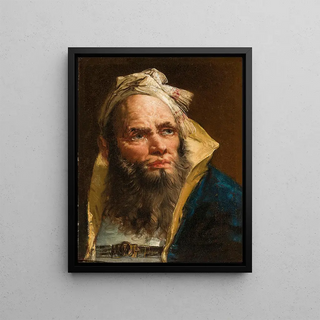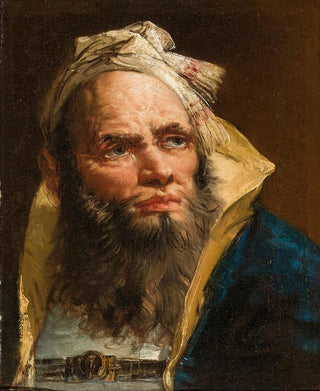Art print | Head of a philosopher - Giovanni Battista Tiepolo


View from behind

Frame (optional)
Giovanni Battista Tiepolo’s “Head of a Philosopher” art print is set within an artistic universe where light and shadow dance in harmony. This enigmatic portrait, imbued with wisdom and reflection, captures the viewer’s attention and invites contemplation. In this representation, Tiepolo manages to encapsulate the very essence of philosophical thought, while revealing a profound humanity. The power of this face, marked by time and experience, resonates with those seeking to understand the mysteries of existence. An undisputed master of the 18th century, Tiepolo transcends mere facial features to create a true symbol of intellectual pursuit.
Style and uniqueness of the art print
Tiepolo’s style is distinguished by his masterful use of light, which appears to emanate from within the figure. In "Head of a Philosopher," this light highlights the contours of the face, emphasizing the wrinkles that betray a life of questioning and reflection. The color palette chosen by the artist, subtly nuanced, gives the art print an atmosphere that is both gentle and dramatic. Every brushstroke demonstrates technical mastery, where detail blends with a certain abstraction, allowing the viewer to interpret the work according to their own sensitivity. This blend of realism and idealism makes this head a true emblem of philosophical thought, while remaining accessible to a broad audience.
The artist and his influence
Giovanni Battista Tiepolo, born in 1696 in Venice, is one of the greatest representatives of rococo. His work is characterized by a constant pursuit of beauty and harmony, features of an era where art strives to transcend reality. Tiepolo succeeded in establishing himself in the art world through his ability to fuse Italian influences with European currents of his time. Through his portraits, he immortalized iconic figures while infusing a philosophical dimension into his creations. His influence endures beyond his era, inspiring many artists who see in him a model of virtuosity and

Matte finish

View from behind

Frame (optional)
Giovanni Battista Tiepolo’s “Head of a Philosopher” art print is set within an artistic universe where light and shadow dance in harmony. This enigmatic portrait, imbued with wisdom and reflection, captures the viewer’s attention and invites contemplation. In this representation, Tiepolo manages to encapsulate the very essence of philosophical thought, while revealing a profound humanity. The power of this face, marked by time and experience, resonates with those seeking to understand the mysteries of existence. An undisputed master of the 18th century, Tiepolo transcends mere facial features to create a true symbol of intellectual pursuit.
Style and uniqueness of the art print
Tiepolo’s style is distinguished by his masterful use of light, which appears to emanate from within the figure. In "Head of a Philosopher," this light highlights the contours of the face, emphasizing the wrinkles that betray a life of questioning and reflection. The color palette chosen by the artist, subtly nuanced, gives the art print an atmosphere that is both gentle and dramatic. Every brushstroke demonstrates technical mastery, where detail blends with a certain abstraction, allowing the viewer to interpret the work according to their own sensitivity. This blend of realism and idealism makes this head a true emblem of philosophical thought, while remaining accessible to a broad audience.
The artist and his influence
Giovanni Battista Tiepolo, born in 1696 in Venice, is one of the greatest representatives of rococo. His work is characterized by a constant pursuit of beauty and harmony, features of an era where art strives to transcend reality. Tiepolo succeeded in establishing himself in the art world through his ability to fuse Italian influences with European currents of his time. Through his portraits, he immortalized iconic figures while infusing a philosophical dimension into his creations. His influence endures beyond his era, inspiring many artists who see in him a model of virtuosity and






